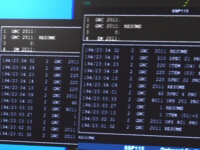Space Shuttle Discovery on Dec 9, 2006.
Mission Control is located in Building 30 of the Lyndon B. Johnson Space Center (JSC) in Houston, Texas. Mission Control is reponsible for all human spaceflight for the United States. There are two Flight Control Rooms (FCRs, pronounced "ficker"). The Blue Flight Control Room (BFCR) directs the International Space Station, while the White Flight Control Room (WFCR) controls the Space Shuttle. The images on this page depict the Shuttle Flight Control Room (WFCR).

The STS-116 insignia is depicted here, since it was in space when I was working on this project.
To the left of the door are three plaques from American missions that resulted in the loss of life. The Space Shuttle Challenger (STS-51L) was lost in 1986 shortly after liftoff. The Space Shuttle Columbia (STS-107) was lost during reentry in 2002. The Apollo I mission (retroactively named) was lost during a training exercise. The Mission Operations Directorate plaque is posted on top.
Also visible in this image is one of the cameras that is used to film the Flight Control team (for NASA TV).


Behind the last row is a viewing gallery for the media (and the public?).


The front row of Mission Control is affectionately known as "the trench." During liftoff, the Flight Dynamics Officer (FDO) monitors the shuttle performance, flight path and assesses abort modes. An ascent/entry expert monitors guidance, navigation and crew execution of ascent commands.
In this image, we see the flight controllers monitoring the shuttle ascent. The launch digitals screen shows measurements from the Primary Avionics Software System (PASS), Backup Flight System (BFS) and Ground (GND). The Mission Elapsed Time (MET) shows that we are about ten minutes after liftoff.
On the side wall, you can see the mission insignia for previous shuttle missions.
The human models in this scene have only the most basic of textures since they were in the distance for the original image. Desk clutter is also missing because it was hidden behind other objects.
The ground controller maintains and directs activities related to the Mission Control hardware and software and coordinates vehicle tracking activities.


The name CAPCOM (Capsule Communicator) is a hold over from when manned spacecraft were called capsules. The CAPCOM is (always?) an astronaut who serves as the single point of contact with the crew.
The people depicted in these images are purely imaginary. There is no intention to portray actual NASA employees or contractors. Any similarity to any real person is entirely unintentional and purely coincidental.


Evolution of this project





I managed to create 80 images:
3 flags (Canada, US, Chile),
9 space agency logos,
2 sheets from the Space Shuttle Operational Flight Rules Manual,
the Earthrise print,
8 detailed computer screens,
57 randomly generated computer screens
These images were all generated with POV-Ray (using CSG and text). An orthographic projection and a clock-based case statement allowed me to rapidly regenerate them all. To see them all, click on the image to the right.
Although I tried to make them as accurate as possible, the resolution of the final image didn't require every last detail.


There are two steps to render the project:
- Render mcc_img.pov (see the file for the correct command-line parameters) to generate 80 image_maps (mostly computer screens).
- Render rf_mcc.pov

KSC Science (NASA)
Wikipedia's entry on Mission Control and Flight Controller
During Shuttle Flights NASA TV often broadcasts from Mission Control.

Finite objects: 20301
Infinite objects: 2
Light sources: 73
Total: 20376
Render Statistics
Image Resolution 1024 x 768
Pixels: 798065 Samples: 2784841 Smpls/Pxl: 3.49
Rays: 62189851 Saved: 2573407 Max Level: 20/20
Ray->Shape Intersection Tests Succeeded Percentage
Bicubic Patch 9778747 2291175 23.43
Box 3746172346 1951247080 52.09
Cone/Cylinder 4933095661 1033963069 20.96
CSG Intersection 1105013088 284947084 25.79
CSG Merge 629969433 205641197 32.64
CSG Union 685027336 140790082 20.55
Mesh 2111490953 1451863299 68.76
Plane 5596680198 3654434915 65.30
Prism 209205598 84216449 40.26
Prism Bound 759533746 641110644 84.41
Sphere 2481959028 131632495 5.30
Sphere Sweep 40939743 1732161 4.23
Superellipsoid 220511670 97191809 44.08
Torus 5911948076 152386668 2.58
Torus Bound 5911948076 174512975 2.95
True Type Font 1865981622 6529787 0.35
Bounding Object 153555135 69512456 45.27
Clipping Object 163315635 135352027 82.88
Bounding Box 377808901855 120946353396 32.01
Light Buffer 7516761590 2561124851 34.07
Vista Buffer 162255037 104008388 64.10
Roots tested: 969566171 eliminated: 48346441
Calls to Noise: 18087182 Calls to DNoise: 3570371
Media Intervals: 83434 Media Samples: 612914 (7.35)
Shadow Ray Tests: 4388381773 Succeeded: 3088536138
Reflected Rays: 8185004
Transmitted Rays: 15468756
Radiosity samples calculated: 550250 (1.31 %)
Radiosity samples reused: 41505089
Smallest Alloc: 34 bytes
Largest Alloc: 48000032 bytes
Total Scene Processing Times
Parse Time: 0 hours 2 minutes 3 seconds (123 seconds)
Photon Time: 0 hours 0 minutes 0 seconds (0 seconds)
Render Time: 13 hours 1 minutes 0 seconds (46860 seconds)
Total Time: 13 hours 3 minutes 3 seconds (46983 seconds)
CPU time used: kernel 15.45 seconds, user 46291.84 seconds, total 46307.30 seconds
Render averaged 16.98 PPS over 786432 pixels
POV-Ray finished


